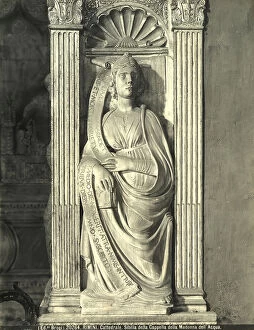Sibylhigh Renaissance Collection
The Sibyls of the High Renaissance were revered figures in art, known for their prophetic abilities and wisdom
For sale as Licensed Images
Choose your image, Select your licence and Download the media
The Sibyls of the High Renaissance were revered figures in art, known for their prophetic abilities and wisdom. One such depiction can be found in Michelangelo's study for a Sibyl of the Sistine Chapel, housed in the Gallerie dell'Accademia in Venice. This drawing showcases the artist's mastery of form and his ability to capture the ethereal beauty of these mythical beings. Another remarkable portrayal is seen in a bas relief by Agostino di Duccio and his helpers, located in the Madonna dell'Acqua Chapel within Malatesta Temple, Rimini. The intricate details and delicate carving bring this Sibyl to life, her expression filled with enigmatic knowledge. In Bologna, we find further evidence of the influence of Sibyls on Renaissance art. The splay of the right portal at the Church of S. Petronio features a captivating representation that highlights their importance as divine messengers. A detail from one door-post at Basilica St. Petronius also showcases a striking image that captures both strength and grace. Agostino di Duccio's bas reliefs continue to impress with their portrayal of various Sibyls within Madonna dell'Acqua Chapel at Malatesta Temple, Rimini. Each work displays meticulous craftsmanship and an understanding of classical mythology. These depictions serve as reminders not only of ancient legends but also as symbols representing human curiosity about what lies beyond our mortal realm. In capturing these mystical figures through their artistry, Renaissance artists immortalized both their own creativity and humanity's fascination with divination. Through these works, we are transported back to an era where belief systems intertwined seamlessly with artistic expression—a testament to how deeply ingrained spirituality was during this period. The reverence shown towards these prophetesses reflects society's desire for guidance amidst uncertainty.





